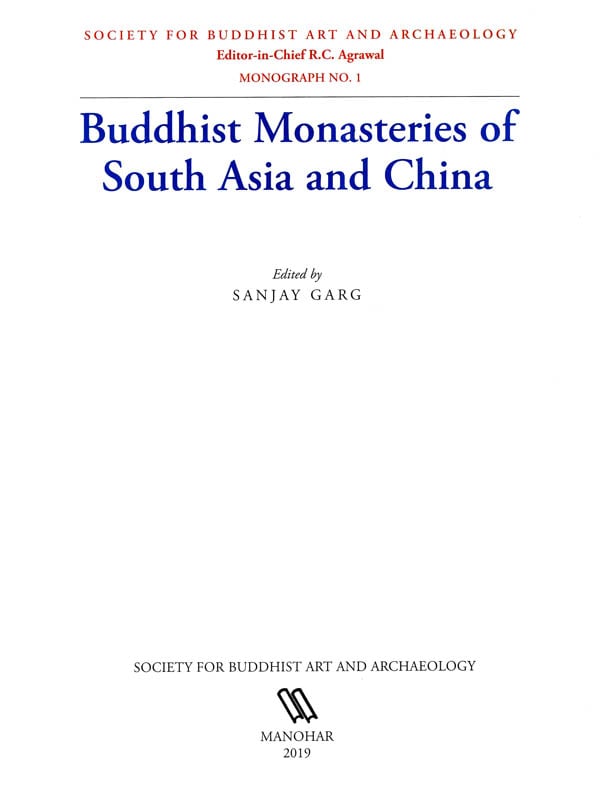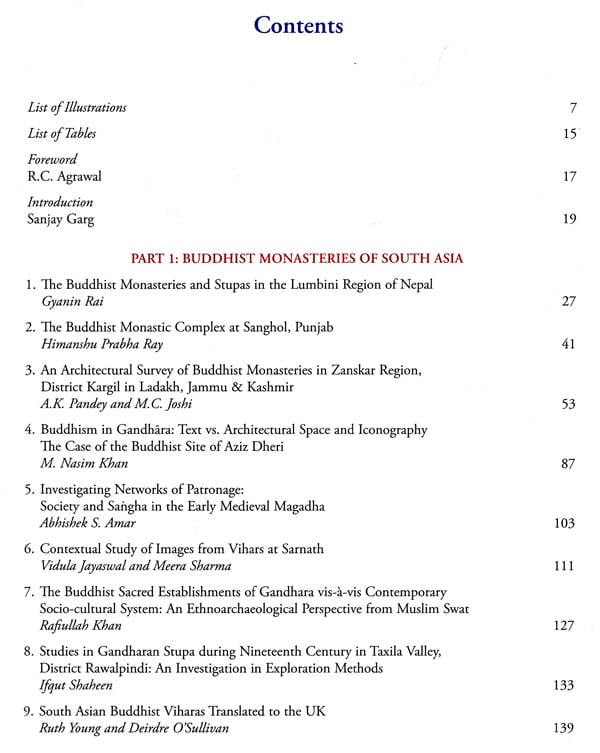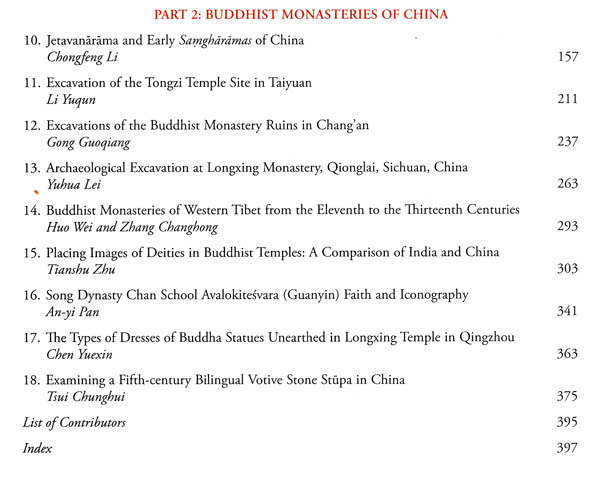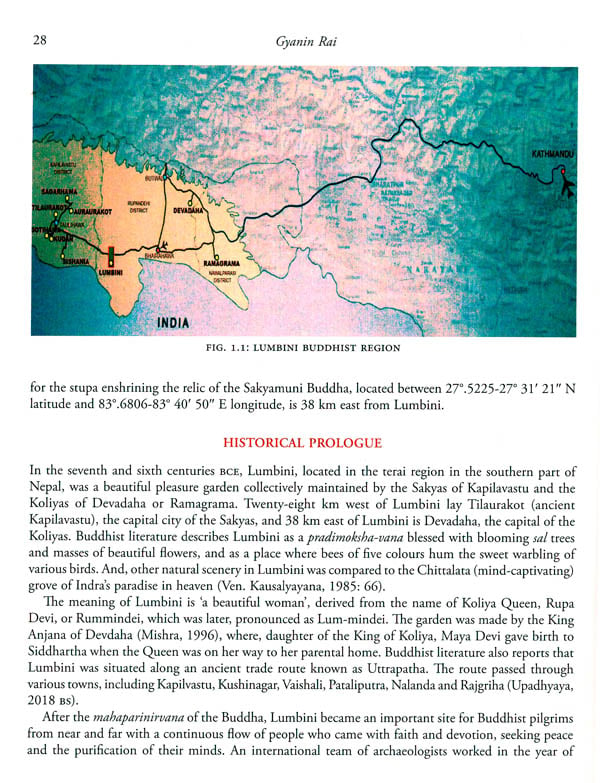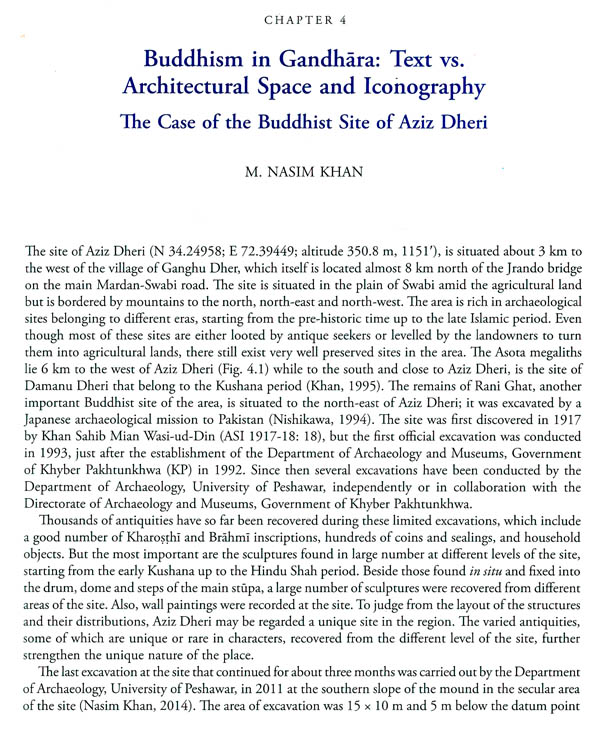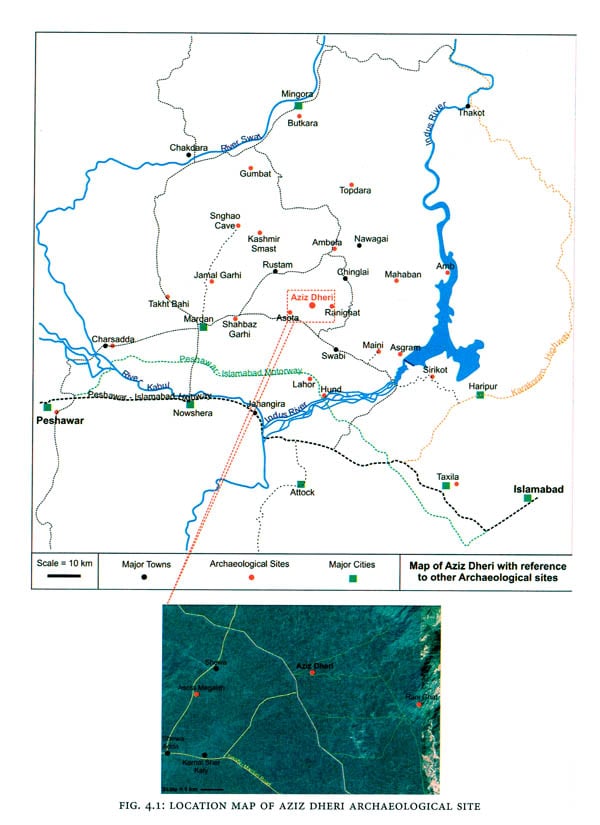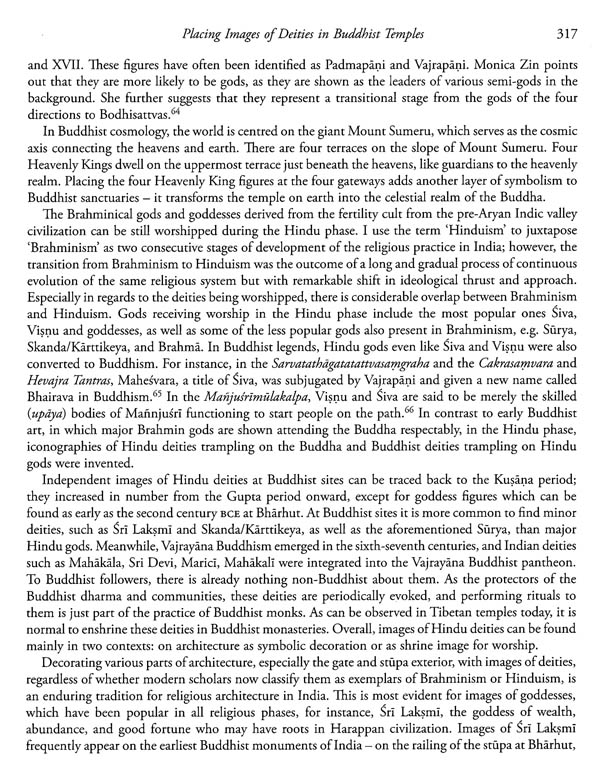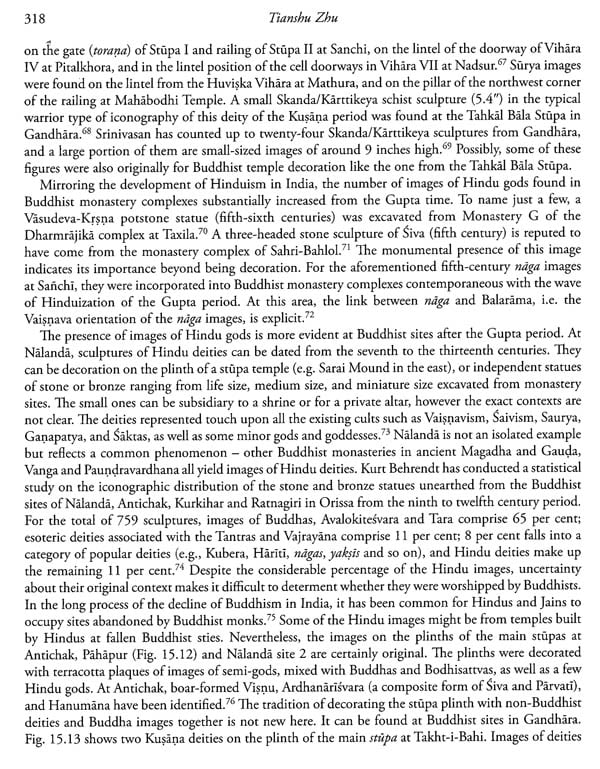
Buddhist Monasteries of South Asia and China
Book Specification
| Item Code: | NAW748 |
| Author: | Sanjay Garg |
| Publisher: | MANOHAR PUBLISHERS and DISTRIBUTORS |
| Language: | English |
| Edition: | 2019 |
| ISBN: | 9789350981603 |
| Pages: | 403 (Throughout Color Illustrations) |
| Cover: | HARDCOVER |
| Other Details | 10.00 X 7.50 inch |
| Weight | 1.19 kg |
Book Description
Buddhism binds the two most populated regions of the world - South Asia and China. In developing a holistic understanding of the historical linkages between these two regions, scientific studies of the Buddhist texts, its monumental and material remains and numerous archaeological sites have played a very important role. The results of recent excavations at many such sites have altered our understanding of monasteries as mere residences for monks and have simultaneously revealed the existence of many important Buddhist centres which were an integral part of the cultural and religious fabric of the society. These excavations have also brought forth the need for studying these sites in a wider religious landscape and network.
This volume contains 18 papers that were presented by leading archaeologists and art historians from South Asia and China at an international conference on ‘Buddhist Monasteries in South Asia and China’ organized by the Society for Buddhist Art and Archaeology (SBAA) in New Delhi in December 2015. These contributions focus on themes such as: newly discovered or worked Buddhist monastery and temple sites in South Asia and China; a comparative study of design of the Buddhist monastery in the two regions; stupas, paintings and sculptures discovered in the Buddhist monastery sites and documents and inscriptions related to the Buddhist monastery and temple.
This volume aims to provide fresh insights and information on new sites and place them along with the earlier known ones in a wider cultural landscape.
Sanjay Garg is an eminent scholar with extensive research experience in history of South Asia, with specialization on economic and monetary history, currency and coinage, architecture and archival studies. His research findings have been widely published in print and multimedia which include twenty-three books and over eighty research papers.
Sixth century BCE was a remarkable period for the spiritual and intellectual ferment in many countries. In China we had Lao Tzu and Confucius, in Greece Permenides and Empedocles, in Persia Zarathustra, and in India Mahavir and the Buddha. In that period these remarkable teachers worked upon their inheritance and developed new points of view and laid the foundation of ideologies for the well-being of the humanity. Gautam Buddha, the tathagat, showed a new path of karuna (compassion) which paved the way for a new religion - Buddhism. The religion and philosophy of the Buddha spread far and wide and covered larger part of Asia. Today the larger part of South Asia consists of Afghanistan, Bangladesh, Bhutan, India, Maldives, Myanmar, Nepal, Pakistan and Sri Lanka. It is home to about 24 per cent of world population and forms the Buddhist heartland of all major historical sites connected with the life of Buddha. Likewise China with about 19.4 per cent of the world population has a long history of Buddhist art and architecture.
With a view to promote studies and research into Buddhist heritage of South Asia and China, the interested scholars conceptualized and constituted the Society for Buddhist Art and Archaeology (SBAA) in 2014, which organized its first International Conference in Delhi in collaboration with India International Centre (IIC)-Asia Project, the Rock Art Society of India and supported by Indian Council for Cultural Relations (ICCR), Indian Council for Historical Research (ICHR), Archaeological Survey of India (ASI), and the Institute of Archaeology. The Society also received support from subject experts: Dr B.M. Pande, former Director, Archaeological Survey of India; Prof. Himanshu Prabha Ray, former Chairperson, National Monument Authority, Government of India; Dr B.R. Mani, former Additional Director General, ASI, and now Director General, National Museum; Dr S.K. Aruni, Member Secretary, ICHR; Dr Achal Pandya, Director, Conservation Laboratory, Indira Gandhi National Centre for the Art, and many friends and well-wishers.
The Society also received good wishes from Prof. Lokesh Chandra, President ICCR, Dr Kapila Vatsyayan, Chairperson IIC-Asia Project, Prof. Y.S. Rao, Chairman ICHR, and Dr Rakesh Tiwari, DG, ASI. The Conference was themed to focus on Buddhist Monasteries of South Asia and China in which delegates from China, USA, Nepal, UK and from various academic institutions of India participated. Select scholarly contributions at the Conference are incorporated in the succeeding pages.
I thank Dr Sanjay Garg, Joint General Secretary of the SBAA, for meticulously editing the papers and Shri Ramesh Jain, owner of the Manohar Publishers & Distributors, New Delhi for bringing out this volume in time.
Buddhism originated in ancient India around sixth-fifth centuries BCE. That was the period roughly coinciding with the spring and autumn period (770-476 BCE) in Chinese history when various schools of thought, such as Confucianism, and their exponents came to the fore. Politically India was divided into sixteen mahajanpadas (kingdoms), many of which were constantly contending for hegemony in Ganga-Yamuna doab. Finally, in this struggle for power Magadha emerged to prominence under a number of dynasties, peaking with the Maurya dynasty that unified most of the Indian subcontinent in the middle of third century BCE.
Buddhism began to spread to neighbouring countries during the reign of Mauryan King Asoka in the third century BCE. There existed two missions in opposite directions. Theravad sutras written in Pali language spread southward to Sri Lanka, Thailand, Burma and Indonesia while Mahayan sutras spread northward to Central Asia, China, Korea and Japan. According to Chinese documents, Hinayan was fashionable in ancient Kucha.
Trans-border spread of the Buddhist scriptures was greatly facilitated by their translations in the local languages. Initially, up till about fourth century CE, scriptures in Prakrit language were used to spread Buddhism. Later, Buddhist scriptures in Sanskrit became quite widespread, from which these were translated into the Central Asian languages and then into Chinese. The Chinese Tripitaka is the most complete collection of extant Buddhist scriptures; its influence reached beyond China to Korea and Japan as well as to Vietnam. During the seventh century CE Buddhism spread from India to Tibet and as Buddhist sutras were gradually and systematically translated into its local language, Tibetan Buddhism came into being.
Relics of Buddhism of different stages have been found in China in the shape of monasteries, stupas, Buddha images and ritual implements which present a good combination of Chinese and Western elements. Buddhist sculptures are in the form of cave carvings, painted clay figures, etc.
In the spread and propagation of the Buddhist doctrines the Buddhist monasteries played a major role. These monasteries not only promoted and patronized different architectural styles and art forms such as paintings and sculptures, but also served as major repositories of the sacred texts. In addition many monasteries also played a social role by hosting community kitchens and running hospitals for the common people.
This volume is a result of an international conference on Buddhist monasteries in South Asia and China that was organized by the Society for Buddhist Art and Archaeology in New Delhi in December 2015. The Conference invited papers on the following themes:
1. Buddhist monastery and temple sites in South Asia,
2. Buddhist monastery and temple sites in China,
3. Design of the Buddhist monastery in South Asia and China: A comparative study,
4. Stupas, paintings and sculptures discovered in the Buddhist monastery sites, and
5. Documents and inscriptions related to the Buddhist monasiery and temple.
Select contributions presented at the said Conference have been included in this volume. While there is unanimity on the need to enlarge the ambit of studies on monasticism and monasteries in South Asia and China, there is still a wide chasm as far as sharing of research findings between the two regions is concerned. This is primarily due to the language barrier and it is hoped that by providing a common platform and through translations this gulf could be bridged to a great extent.
The consistent and dedicated endeavours by archaeologists in South Asia and China have brought to light many hitherto unknown or understudied Buddhist monastic sites. The results of excavations have altered our understanding of monasteries as mere residences for monks, and have simultaneously revealed the existence of many important Buddhist centres which were an integral part of the cultural and religious fabric of the society. Excavations at these sites have also brought forth the necessity of placing these sites in a wider religio-cultural landscape and network. Simultaneously, many of these excavations also make it evident that the construction of Buddhist monastic establishments was done at sites which have evidence of earlier settlements. This, in turn, reminds us of the need to analyse the role of the varied communities in the maintenance and continued support at the sites and the relations and also the links between various monastic sites. It also resurrects one of the much debated questions relating to the causes behind the decline of Buddhism in India. One of the reasons attributed is the decline in trade and urbanism. However, in the period of decline, a few monasteries that managed to survive were supported through land grants, turning them turned into landlords. Academic learning at these monasteries no longer remained the sole prerogative of the monks, but now the lay community could also become a part of academic pursuits at the monasteries. In the long run, however, these monasteries could not compete with the Hindu temples and suffered decline.
In developing a holistic understanding of the religious establishments and their relations with the contemporary society the material remains of the past invariably provide vital clues and leads.
ARCHAEOLOGY
Buddhist monumental remains and archaeological sites have attracted the attention of pilgrims, travellers, explorers, antiquarians, archaeologists, historians, coin-collectors as well as common people from a very early time. One of the most explored areas in this context is the Gandhara region that extended from the Swat Valley and Potohar plateau in Pakistan to the Jalalabad district of north-eastern Afghanistan. Three contributions included in this volume deal with different aspects of the Buddhist archaeology in this region.
Ifqut Shaheen has studied various approaches that were adopted during nineteenth century to understand the Gandharan stupa situated in the Taxila Valley. After contextualizing the accounts of travellers and explorers such as Charles Masson, Alexander Burnes, General Ventura, and Major Court in the study of stupas of this region, she makes an analysis of stupa exploration in Taxila Valley by Alexander Cunningham. During 1860s and 1870s Cunningham explored and documented as many as 27 stupa-sites in the Taxila Valley, including the famous Dharmarajika monastic complex, Bhir mound and Sirkap. The study presents an evolutionary perspective in understanding the archaeology of the region.
Another important Buddhist site in the Gandhara region is Aziz Dheri in the Swabi district in the - Khyber Pakhtunkhwa province of Pakistan. It is one of the largest archaeological mounds in ancient Gandhara with a rich assemblage of cultural artefacts and well organized settlemerit pattern. M. Nasim Khan has been conducting archaeological explorations and excavations at this site since 1993 and he presents a report on the recent findings at Aziz Dheri and studies its impact on the overall history of the religious landscape in the region. Focusing mainly on the chronological sequence of the site, distribution pattern of its relics and iconographic discoveries, his study seeks to redefine the relationship between texts, images and architectural spaces.
Rafiullah Khan gives an ethno-archaeological perspective of the Buddhist sacred establishments of Gandhara vis-a-vis contemporary socio-cultural system. His study reveals that in terms of religiosity a crystal clear cultural continuity can be observed in Gandhara despite the fact that radical eschatological transformations have subsequently occurred in that region. Juxtaposing the socio-religious system of mosques and madrasas in the present-day Swat spanning over the-last four/five centuries with the Buddhist stupas and monasteries in the region, he analyses the data to show the system of property rights and its management regarding Buddhist sacred establishments and people's spiritual, political and economic engagements with these institutions.
**Contents and Sample Pages**
